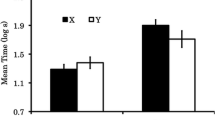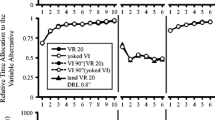Abstract
The results of the present study are inconsistent with several previous reports of positive contrast in rats receiving discrimination training in mixed schedules of reinforcement. Using a semimixed schedule (i.e., A mixed schedule with blackouts between successive components) containing the parameters of a multiple schedule that have previously, in our laboratory, produced positive contrast in rats reliably, positive contrast was obtained in semimixed extinction variable interval in only two of 21 possible instances. In both of these instances, the effect was extremely small. In comparison, multiple extinction variable interval produced positive contrast in seven of seven instances, although the effects here were somewhat fragile. These findings have implications for both the optimal stimulus conditions for obtaining positive contrast in rats as well as the control conditions needed to validate its occurrence.
Similar content being viewed by others
References
BENINGER, R. J., & KENDALL, S. B. (1975). Behavioral contrast in rats with different reinforcers and response topographies. Journal of the Experimental Analysis of Behavior, 24, 267–280.
FARTHING, G. W. (1975). Behavioral contrast in pigeons learning an auditory discrimination. Bulletin of the Psychonomic Society, 6, 123–125.
FREEMAN, B. J. (1971). The role of response independent reinforcement in producing behavioral contrast effects in rats. Learning and Motivation, 2, 138–147.
GUTMAN, A. (1977). Positive contrast, negative induction, and inhibitory stimulus control in the rat. Journal of the Experimental Analysis of Behavior, 27, 219–233.
GUTMAN, A. (1978). The effect of extended baseline training on positive behavioral contrast: Reversible and preventable retardation. The Psychological Record, 28, 399–404.
GUTMAN, A., & MINOR, T. (1976). Local positive behavioral contrast in the rat. The Psychological Record, 26, 349–354.
GUTMAN, A., & SUTTERER, J. R. (1977). The effect of discrimination training on the response rate and response duration of the rat. Animal Learning and Behavior, 23, 247–252.
GUTMAN, A., SUTTERER, J. R., & BRUSH, F. R. (1975). Positive and negative behavioral contrast in the rat. Journal of the Experimental Analysis of Behavior, 23, 377–383.
HEARST, E., & GORMLEY, D. (1976). Some tests of the additivity theory of behavioral contrast. Animal Learning and Behavior, 4, 145–150.
HEARST, E., & JENKINS, H. M. (1974). Sign tracking: The stimulus-reinforcer relation and directed action. Austin, TX: The Psychonomic Society.
HENKE, P. G. (1972). Amygdalectomy and mixed reinforcement schedule contrast effects. Psychonomic Science, 28, 301–302.
HEMMES, N. S. (1973). Behavioral contrast in the pigeon depends upon the operant. Journal of Comparative and Physiological Psychology, 85, 171–178.
PEAR, J. J., & WILKIE, D. M. (1969). Stimulus change as a discriminative event in a semimultiple schedule. Proceedings of the 77th Annual Convention of the American Psychological Association (pp. 797–798).
PEAR, J. J., & WILKIE, D. M. (1970). Behavioral contrast in mixed schedules of reinforcement. Psychonomic Science, 20, 167–168.
PEAR, J. J., & WILKIE, D. M. (1971). Contrast and induction in rats on multiple schedules. Journal of the Experimental Analysis of Behavior, 15, 289–296.
RACHLIN, H. (1973). Contrast and matching. Psychological Review, 80, 217–234.
REYNOLDS, G. S. (1961). Behavioral contrast. Journal of the Experimental Analysis of Behavior, 4, 57–71.
SCHWARTZ, B. (1975). Discriminative stimulus location as a determinant of positive and negative behavioral contrast in the pigeon. Journal of the Experimental Analysis of Behavior, 23, 167–176.
SCHWARTZ, B., & GAMZU, E. (1977). Pavlovian control of operant behavior. In W. K. Honig & J. E. R. Staddon (Eds.), Handbook of operant behavior. Englewood Cliffs, NJ: Prentice Hall.
SHANAB, M. E., & KONG, J. (1977). Failure to obtain positive contrast in the rat following extinction acquisition. The Journal of General Psychology, 96, 95–102.
STERN, S., & ECKERMAN, D. A. (1974, April). Behavioral contrast in multiple schedules may result from persistence of topographical shifts in responding. Paper presented at the Annual Meeting of the Eastern Psychological Association, Philadelphia, Pa.
WESTBROOK, R. F. (1973). Failure to obtain positive contrast when pigeons press a bar. Journal of the Experimental Analysis of Behavior, 20, 499–510.
Author information
Authors and Affiliations
Rights and permissions
About this article
Cite this article
Gutman, A., Minor, T.R. & Sutterer, J.R. Discrimination Training in Semimixed and Multiple Schedules. Psychol Rec 34, 427–435 (1984). https://doi.org/10.1007/BF03394885
Published:
Issue Date:
DOI: https://doi.org/10.1007/BF03394885




